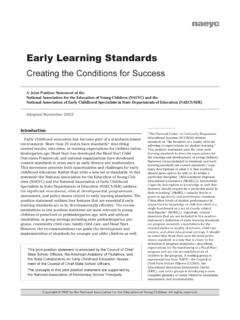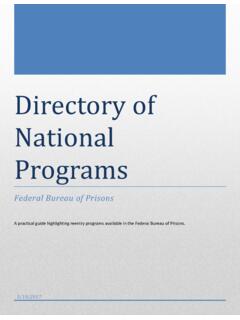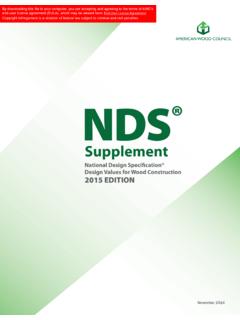Transcription of U.S. Department of Justice Office of Justice Programs ...
1 Department of JusticeOffice of Justice ProgramsNational Institute of JusticeNational Institute of JusticeColor Test Reagents/Kits forPreliminary Identificationof Drugs of AbuseNIJ Standard Enforcement and Corrections standards and Testing Program ABOUT THE LAW ENFORCEMENT AND CORRECTIONSSTANDARDS AND TESTING PROGRAMThe Law Enforcement and Corrections standards and Testing Program is sponsored by the Office of Science andTechnology of the national Institute of Justice (NIJ), Department of Justice . The program responds to themandate of the Justice System Improvement Act of 1979, which directed NIJ to encourage research and developmentto improve the criminal Justice system and to disseminate the results to Federal, State, and local Law Enforcement and Corrections standards and Testing Program is an applied research effort thatdetermines the technological needs of Justice system agencies, sets minimum performance standards for specificdevices, tests commercially available equipment against those standards , and disseminates the standards and the testresults to criminal Justice agencies nationally and program operates through.
2 The Law Enforcement and Corrections Technology Advisory Council (LECTAC), consisting of nationallyrecognized criminal Justice practitioners from Federal, State, and local agencies, which assesses technological needsand sets priorities for research Programs and items to be evaluated and Office of Law Enforcement standards (OLES) at the national Institute of standards and Technology, whichdevelops voluntary national performance standards for compliance testing to ensure that individual items of equipmentare suitable for use by criminal Justice agencies. The standards are based upon laboratory testing and evaluation ofrepresentative samples of each item of equipment to determine the key attributes, develop test methods, and establishminimum performance requirements for each essential attribute. In addition to the highly technical standards , OLES also produces technical reports and user guidelines that explain in nontechnical terms the capabilities of national Law Enforcement and Corrections Technology Center (NLECTC), operated by a grantee, whichsupervises a national compliance testing program conducted by independent laboratories.
3 The standards developed byOLES serve as performance benchmarks against which commercial equipment is measured. The facilities, personnel,and testing capabilities of the independent laboratories are evaluated by OLES prior to testing each item of equipment,and OLES helps the NLECTC staff review and analyze data. Test results are published in Equipment PerformanceReports designed to help Justice system procurement officials make informed purchasing are available at no charge through the national Law Enforcement and Corrections TechnologyCenter. Some documents are also available online through the Internet/World Wide Web. To request a document oradditional information, call 800 248 2742 or 301 519 5060, or write: national Law Enforcement and Corrections Technology Box 1160 Rockville, MD 20849 1160E-Mail: Wide Web address: national Institute of Justice is a component of the Officeof Justice Programs , which also includes the Bureau of JusticeAssistance, the Bureau of Justice Statistics, the Office ofJuvenile Justice and Delinquency Prevention, and the Office forVictims of Department of JusticeOffice of Justice ProgramsNational Institute of JusticeColor Test Reagents/Kits for PreliminaryIdentification of Drugs of AbuseNIJ Standard?
4 NILECJ STD , Chemical Spot Test Kits forPreliminary Identification of Drugs of Abuse, dated December1978, and NIJ Standard , Color Test Reagents/Kits forPreliminary Identification of Drugs of Abuse, dated July 1981 Coordination by: national Institute of standards and TechnologyOffice of Law Enforcement StandardsGaithersburg, MD 20899 8102 Prepared for: national Institute of JusticeOffice of Science and TechnologyWashington, DC 20531 July 2000 NCJ 183258 national Institute of JusticeJulie E. SamuelsActing DirectorThe technical effort to develop this report was conductedunder Interagency Agreement 94 IJ R 004,Project No. 97 028 standard was formulated by the Office of Law EnforcementStandards (OLES) of the national Institute of Standardsand Technology (NIST) under the direction ofAlim A. Fatah, Program Manager for Chemical Systemsand Materials, and Kathleen M. Higgins, Director of of this standard was performed at theUniversity of Utah, Center for Human Toxicology (CHT)by Dennis J.
5 Crouch, Interim Director of work resulting from this report was sponsored by theNational Institute of Justice (NIJ), David G. Boyd, Director, Office of Science and document, NIJ Standard? , Color Test Reagents/Kits for PreliminaryIdentification of Drugs of Abuse, is an equipment standard developed by the Office of LawEnforcement standards of the national Institute of standards and Technology. It was producedas part of the Law Enforcement and Corrections standards and Testing Program of the NationalInstitute of Justice . A brief description of the program appears on the inside front standard is a technical document that specifies performance and other requirementsequipment should meet to satisfy the needs of criminal Justice agencies for high-quality can use the test methods described in this standard to determine whether a particularpiece of equipment meets the essential requirements, or they may have the tests conducted ontheir behalf by a qualified testing laboratory.
6 Procurement officials may also refer to thisstandard in their purchasing documents and require that equipment offered for purchase meet therequirements. Compliance with the requirements of the standard may be attested to by anindependent laboratory or guaranteed by the this NIJ standard is designed as a procurement aid, it is necessarily highlytechnical. For those who seek general guidance concerning the selection and application of lawenforcement equipment, user guides have also been published. The guides explain innontechnical language how to select equipment capable of the performance required by standards are subjected to continuing review. Technical comments and recommendedrevisions are welcome. Please send suggestions to the Director, Office of Science andTechnology, national Institute of Justice , Department of Justice , Washington, DC citing this or any other NIJ standard in a contract document, users should verify thatthe most recent edition of the standard is used.
7 Write to: Director, Office of Law EnforcementStandards, national Institute of standards and Technology, Gaithersburg, MD 20899 G. Boyd, DirectorOffice of Science and TechnologyNational Institute of USED SYMBOLS AND Munsell Color Centroid Color Final User Safe-Disposal Color Test Color and Drug Detection TEST General Test Test Drug Detection Limit Specificity A B SAFETY C STORAGE 1. Final colors produced by reagents through with various drugs and other 2. Drug detection 3. Specificity of color COMMONLY USED SYMBOLS AND ABBREVIATIONSA ampereHhenrynmnanometeracalternating modulationhfhigh diametercdcandelaHzhertz pureininchPapascalc/scycle per secondIRinfraredpeprobable per milliondcdirect currentLliterqtquart Cdegree Celsiuslbpoundradradian Fdegree Fahrenheitlbfpound-forcerfradio frequencydiadiameterlbf inpound-force inchrhrelative humidityemfelectromotive forcelmlumenssecondeqequationlnlogarithm (base e)SDstandard deviationFfaradloglogarithm (base 10) wave frequencyFMfrequency modulationminminuteUVultravioletftfootmm millimeterVvoltft/sfoot per secondmphmiles per hourvhfvery high frequencygaccelerationm/smeter per secondWwattggramNnewton wavelengthgrgrainN mnewton meterwtweightarea=unit2 ( , ft2, in2, etc.)
8 ; volume=unit3 ( , ft3, m3, etc.)PREFIXES ddeci (10-1)dadeka (10)ccenti (10-2)hhecto (102)mmilli (10-3)kkilo (103) micro (10-6)Mmega (106)nnano (10-9)Ggiga (109)ppico (10-12)Ttera (1012)COMMON CONVERSIONS(See ASTM E380) m = N = cm = 1 J =1 ft kg = 1 N m = lbf = N/m =1 L = 1 Pa = 1 lbf/in23600000 J = 1 kW km/h = mphTemperature: T?C = (T?F-32) 5/9 Temperature: T?F = (T?C 9/5)+32vi1 NIJ Standard STANDARDFORCOLOR TEST REAGENTS/KITS FORPRELIMINARY IDENTIFICATIONOF DRUGS OF ABUSE1. PURPOSEThe purpose of this standard is to establish minimum requirements for color test reagent/kitsto detect drugs of abuse and methods of testing the reagents to determine compliance with SCOPEThis standard applies to field-testing kits that consist of color test reagents for thepreliminary identification of drugs of abuse (hereinafter referred to simply as drugs) in their pureand/or diluted forms. It does not apply to kits that use thin layer chromatography as theidentification procedure nor to kits that identify drugs in body standard supersedes NILECJ STD , Chemical Spot Test Kits for PreliminaryIdentification of Drugs of Abuse, December 1978, and NIJ Standard , Color TestReagents/Kits for Preliminary Identification of Drugs of Abuse, July 1981.
9 The standard isconcerned with single reagents (or reagent combinations) used to give a preliminary identi-ficationof a suspected drug or class of drugs in their pure and/or diluted that this standard does not mandate the identities of the reagents to be included in a testkit. Since they are among the reagents currently in most common use, the 12 reagents listed inappendix A and their color reactions listed in table 1 are included for informational purposes kit may contain any reagent or group of reagents that meet(s) the requirements of this Munsell Color ChartsThe Munsell Book of Color (Volumes 1 and 2) is a master atlas of color. Munsell colorstandards are made by applying a stable coating to a paper or polymer substrate using the most2stable colorants available. The colors are made according to the specifications contained in thefinal report of the subcommittee of the Optical Society of America on the spacing of Munsellcolors, J. Opt. Soc. Am., 33, 385 418 (1943).
10 Samples of each production lot are measured byspectrophotometry and are visually inspected at the time of production. The collection displaysnearly 1 600 color chips, arranged according to the Munsell color-order system. Each pagepresents one hue, and there are 40 pages, each hue steps apart. On each page, the chips arearranged by Munsell value and chroma. The standard way to describe a color using Munsellnotations is to write the numeric designation for the Munsell hue (H) and the numeric designationfor value (V) and chroma (C) in the form of H Centroid Color ChartsThe Centroid Color Charts are a collection of charts, published by the Inter-Society ColorCouncil (ISCC) and the national Institute of standards and Technology (NIST), formally, theNational Bureau of standards (NBS), that logically group and illustrate colors. There is a chartfor each color hue. On each chart, color saturation increases from left to right and color lightnessincreases from bottom to top.
















